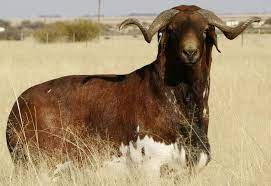On farm phenotypic characterization of indigenous sheep in Simada and Lay gayint districts, South Gonder zone, Ethiopia
Abstract
The study was carried out in Simada and Lay- Gayint districts of South Gonder Zone. The objectives were to describe and phenotypically characterize indigenous sheep populations in the study area. The body measurements were taken from 400 (280 females, 120 males) sheep. The majority of the coat colour pattern of Simada sheep was plain (57%), with the most frequently observed coat color type being light red. Similarly, 67% of the Lay-Gayint sheep had a plain coat color pattern. Majority of Simada and Lay Gayint sheep has short fat-tailed and the tail was cylindrical with the curved tip at the end. The average estimated body weight, heart girth, wither height, and body length for Simada adult male sheep were 27.45±0.18kg, 77.95±0.28 cm, 66.83±0.30cm, and 58.63±0.15cm, respectively. While that for female sheep of the same district was 24.59±0.13kg, 74.60±0.18 cm, 65.64±0.22 cm, and 57.47±0.17cm. Age of sheep had a significant (p<0.01) effect on body weight and many of the linear body measurements. In conclusion, the present morphometric information could aid future decisions on the management, conservation, and improvement of the indigenous sheep genetic resources and provide preliminary information for further research, either genotypic or molecular level characterization of sheep, which would be undertaken to investigate characteristics of the sheep type and estimate its genetic potential.
Downloads
References
Abera M, Kebede K, Mengesha Y. (2016). Phenotypic Characterization of Indigenous Sheep Types In Northern Ethiopia. J Natural Sci Res 6 (15): 16-27.
Amelmal Alemayehu, (2011). Phenotypic characterization of indigenous sheep types of Dawuro zone and Konta special woreda of SNNPR, Ethiopia. An M.Sc Thesis Haramaya University, Haramaya, Ethiopia.
CSA (Central statistical agency) (2021). Agricultural sample survey volume II report on livestock and livestock characteristics, statistical bulletin 589, Addis ababa. FAO (Food and Agricultural Organization) (2011). Draft guidelines on phenotypic characterization of Animal genetic Resources. Commission on genetic resources for food and agriculture thirteenth regularsession.FAO (Food and Agricultural Organization of the United Nations), Rome, Italy. 59p.
Fernandez, M., Giraldez, F.J., Frutos, P., Lavin, P. & Mantecon, A.R. (2004). Effect of undegradable protein supply on testicular size, spermiogram parameters and sexual behavior of mature Assaf rams. Theriogenology 62, 299-310.
Fsahatsion Hailemariam, Dawit Gebremicheal and Hagos Hadgu (2018); Phenotypic characterization of sheep breeds in Gamogofa zone. Agriculture & Food Security 7:17.
Gizaw S, Komen H., Hanote O, Van Arendonk JAM. 2008. Indigenous sheep resources of Ethiopia: types, production systems and Farmers preferences. Anim Genet Res Inf 43: 25-39
Hailu, A., Mustefa, A., Aseged, T., Assefa, A., Sinkie, S., Tsewene, S. (2020). Phenotypic characterization of sheep populations in Tahtay Maichew district, Northern Ethiopia. Genetic Resources 1 (2), 12–22.
Hailu, A., Mustefa, A., Asegede, T., Assefa, A., Sinkie, S. and Tsewene, S. (2020). Phenotypic characterization of sheep populations in Tahtay Maichew district, Northern Ethiopia”, Genetic Resources, 1(2), pp. 12-22.
Mohammed N, Alemayehu K, Getachew T. 2017. On-farm phenotypic characterization of indigenous sheep population and its cross with awassi in selected Districts of South Wollo, Amhara, Ethiopia. Trop Drylands 1: 1-12.
Sisay Lemma (2002). Phenotypic classification and description of indigenous sheep types in the Amhara national regional state of Ethiopia. An M.Sc. Thesis Submitted to the Department of Genetics, University of Natal. Pietermaritzburg,South Africa. 104p.
Solomon Gizaw (2008). Sheep resources of Ethiopia: genetic diversity and breeding strategy PhD thesis, Wageningen University, The Netherland.
Tassew mohammed (2012).On-farm phenotypic characterization of native sheep types and their husbandry practices in north wollo zone of the amhara region. MSc. Thesis, Haramaya University, Haramaya, Ethiopia.
Tesfaye Getachew (2008). Characterization of Menz and Afar indigenous sheep breeds of smallholders and pastoralists for designing community-based breeding strategies in Ethiopia. Msc Thesis, Haramaya University, Haramaya Ethiopia.
Tewodros Bimerow, Asresu Yitayew, Mengstie Taye and shigdaf Mekuriaw (2011). Morphological characteristics of Farta sheep in Amahara region, Ethiopia. J. Anim. Feed Res., 1(6): 299-305
Thiruvenkadan, A. K, (2005). Determination of best-fitted regression model for estimation of body weight in Kanni Adu Kids under farmer’s management system. Livestock research for Rural Development.17: 1- 11.
Wossenie Shibabaw (2012). On-farm phenotypic characterization of hararghe highland sheep and their production practices in eastern hararghe zone, Ethiopia. MSc Thesis, Haramaya University, Haramaya, Ethiopia
Yoseph Mekasha, 2007. Reproductive traits in Ethiopian male goats: With special reference to breed and nutrition. Doctoral thesis, Swedish University of Agricultural Sciences, Uppsala, Sweden.
Zewdu Edea. 2008. Characterization of Horro and Bonga indigenous sheep breeds of smallholders for designing community based-breeding strategies. MSC Thesis, Haramaya University, Haramaya, Ethiopia.

Copyright (c) 2021 sintayehu sisay mekonen

This work is licensed under a Creative Commons Attribution-NonCommercial-NoDerivatives 4.0 International License.










